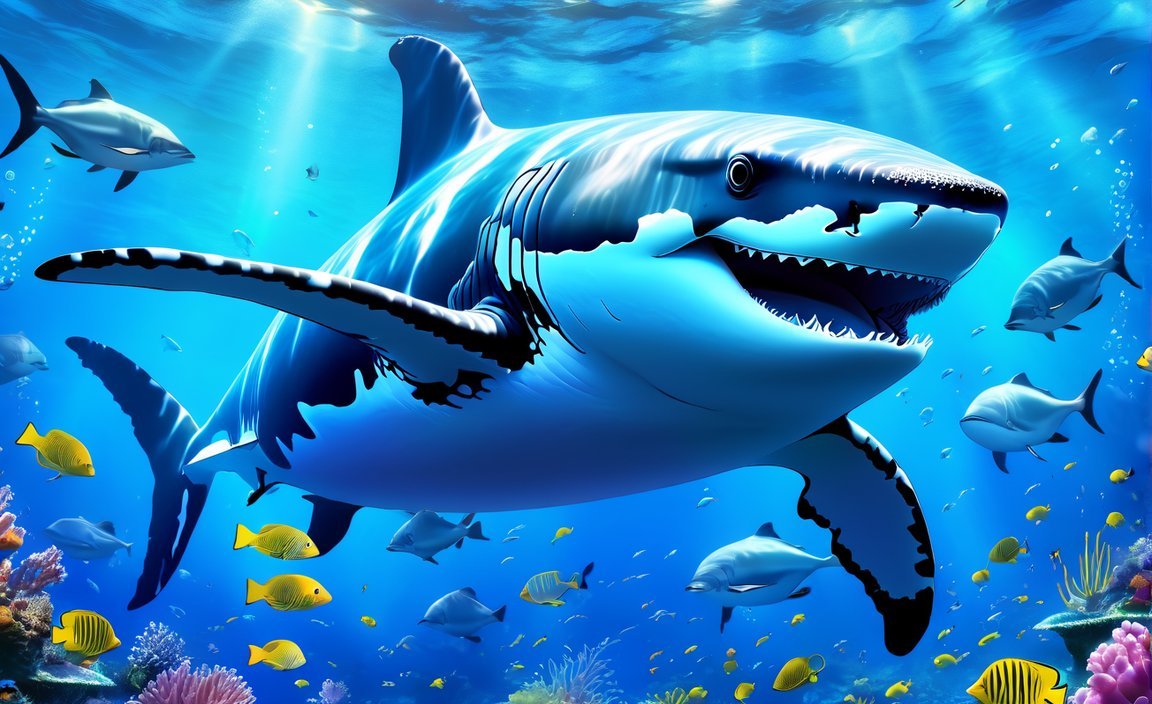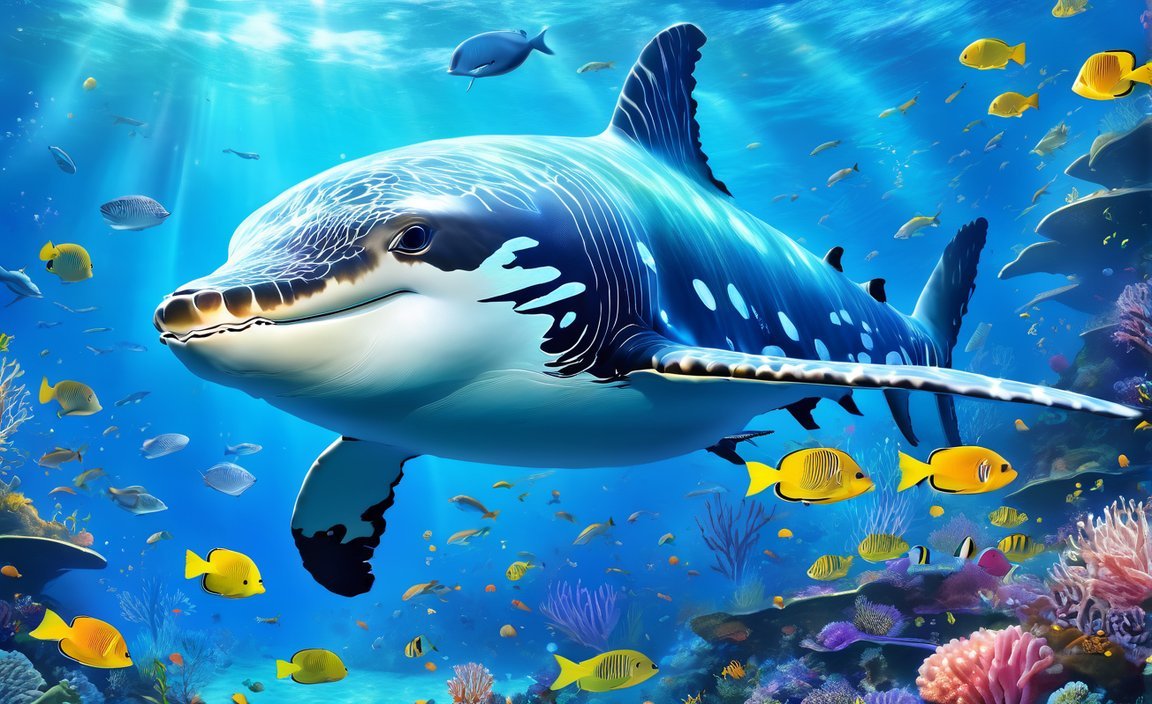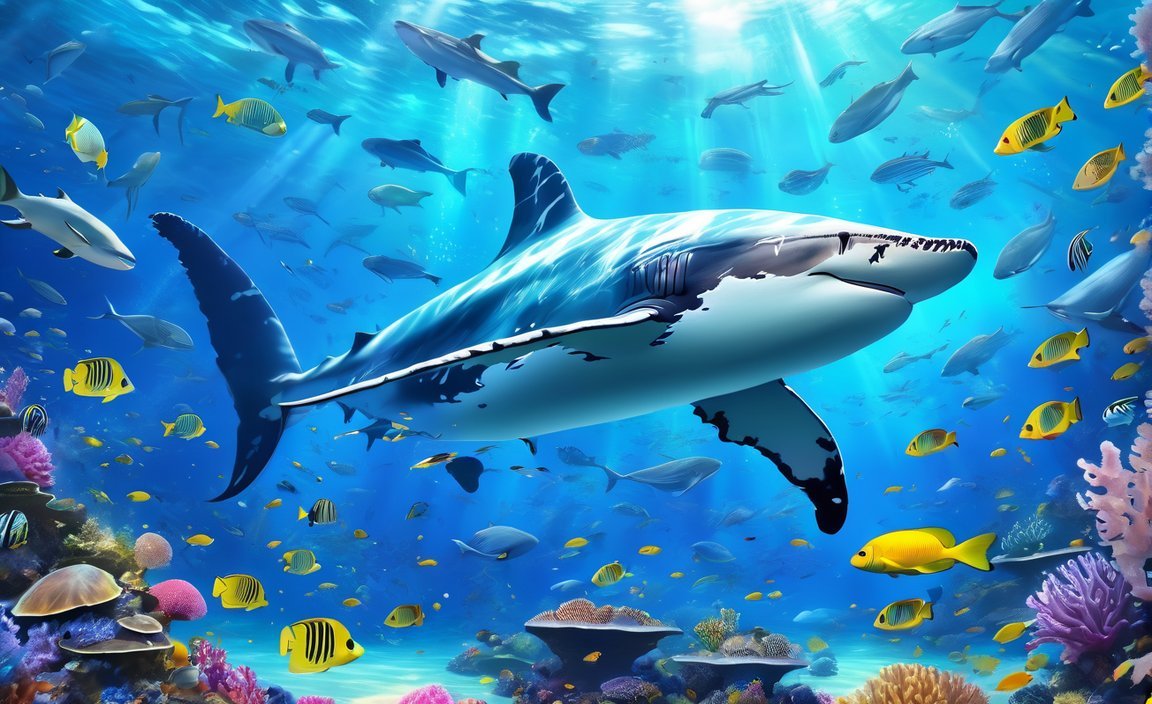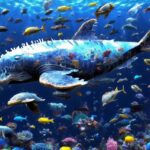Discover 5 Intriguing Facts About Ocean Animals as we dive into the mysteries of the deep blue. From the vastness of the ocean’s depths to the wonders of marine life, this article will unveil fascinating insights about our planet’s remarkable underwater creatures. Prepare to be captivated by the enchanting world of ocean animals and uncover five surprising facts that will leave you in awe.

Key Takeaways:
- There are over one million species of animals in the ocean, with the majority being invertebrates.
- Marine life includes animals, plants, and other organisms that inhabit the ocean.
- Ocean animals vary in size, from microscopic zooplankton to the enormous blue whale, the largest ocean animal.
- There are two major types of seals in the ocean: eared seals (sea lions and fur seals) and true seals (with no external ears).
- The sperm whale has an oil-filled head that prevents it from getting the bends when surfacing from deep dives.
5 Facts About Ocean Animals
The world beneath the waves holds a captivating array of creatures that continue to astound us with their diversity and adaptability. Let’s dive in and explore five intriguing facts about ocean animals that will leave you in awe of nature’s wonders.
Fact 1: A Million Shades of Life
The ocean is a sprawling habitat that teems with life. Did you know that there are approximately one million species of animals living in the ocean? These incredible creatures range from the tiniest microorganisms to the mighty giants of the deep. Among them, invertebrates make up the majority, displaying mesmerizing forms and dazzling colors that seem almost otherworldly.
Fact 2: The Marine Mosaic
When we think of ocean animals, we often envision graceful fish gliding through the water. However, marine life encompasses much more than just fish. It includes an astonishing variety of organisms, such as animals, plants, and even microscopic organisms. Ocean animals constitute an intricate web of interconnected species, each playing a vital role in the delicate balance of marine ecosystems.
Fact 3: Size Matters
The size range of ocean animals is truly mind-boggling. From minuscule plankton drifting in the currents to magnificent giants like the blue whale, which holds the title of the largest ocean animal. These colossal creatures can reach lengths of up to 98 feet and weigh as much as 200 tons. Just imagine the awe-inspiring sight of encountering one of these gentle giants in their watery realm!
Fact 4: Two Types of Seals
Seals, with their endearing expressions and playful nature, are a beloved sight along coastlines. But did you know that there are two main types of seals found in the ocean? Eared seals, such as sea lions and fur seals, possess external ears and are highly agile both on land and in the water. On the other hand, true seals lack external ears and have a unique wriggling movement on land due to their rear-flippers. Both types of seals contribute to the rich tapestry of ocean life.
Fact 5: A Head Full of Secrets
Among the many enigmatic ocean animals, the mighty sperm whale has a fascinating adaptation that protects it during long, deep dives. Its head harbors a reservoir of oil, which prevents the dreaded condition known as “the bends” when it resurfaces. This oil-filled head serves as a natural decompression chamber, allowing the sperm whale to explore the depths in search of its favorite food—giant squid. Imagine the mysteries that lie hidden in the depths, waiting to be unraveled.
The ocean is a treasure trove of remarkable creatures, each with its own story to tell. From the microscopic wonders to the awe-inspiring giants, the myriad ocean animals continue to captivate our imaginations. Take a moment to appreciate the beauty and complexity of these marine marvels, reminding ourselves of the importance of protecting their habitats for generations to come. Who knows what other incredible facts lie waiting to be discovered beneath the waves? The ocean never fails to surprise and inspire us with its endless tales of life.
If you’re fascinated by marine biology, you won’t want to miss these 5 facts about marine biology. Dive into the world of oceanic creatures and learn about their remarkable ecosystems. Click here for an eye-opening experience!
Discover the wonders of the underwater realm with these 5 facts about marine life. From colorful coral reefs to majestic whales, this captivating journey will leave you in awe. Click here to explore the fascinating secrets of marine life.
Prepare to be amazed by the incredible diversity of ocean life. Delve into the mysteries of the deep sea and uncover intriguing facts about its inhabitants. Click here to embark on an enchanting underwater adventure.
Explore the enchanting world of ponds and uncover 5 fascinating facts about ponds. From mesmerizing water lilies to adorable frogs, these insights will make you appreciate the beauty of these freshwater ecosystems. Click here to dive into the wonders of ponds.
Fact 3: The Mantis Shrimp’s Extraordinary Visual System
The mantis shrimp, an ocean creature known for its vibrant colors and powerful punching ability, boasts the most complex visual system ever discovered in an animal. Unlike humans, who have only three types of color-receptive cones in their eyes, mantis shrimp possess a staggering sixteen types of these cones, allowing them to see a vast array of colors and detect subtle variations in light and shade.
A Visual Marvel
The mantis shrimp’s visual system is truly exceptional. Its compound eyes are composed of tens of thousands of individual units called ommatidia. Each tiny ommatidium contains specialized photoreceptor cells, support cells, and pigment cells. Working together, these components enable the mantis shrimp to perceive a rich tapestry of visual information.
Astonishing Perception and Communication
Scientists have conducted behavioral experiments to better understand how mantis shrimp utilize their remarkable visual system for communication and survival. Just as peacocks and chameleons employ visual signals in their behavior, mantis shrimp use their complex visual system to communicate and interact with the world around them. They have the ability to distinguish up to 12 different wavelengths and even polarized light.
Freedom of Vision
One of the mantis shrimp’s most fascinating features is its pair of eyes, which can move independently of each other. This unique adaptation allows the mantis shrimp to scan its surroundings with incredible accuracy and precision. With their trinocular vision and independently roaming eyes, mantis shrimp are adept hunters, always keenly aware of their surroundings.
A Language of Their Own
Researchers have discovered that mantis shrimp possess a secret language to communicate with each other. This intricate language involves complex movements, color changes, and even specific body postures. This remarkable ability showcases the sophistication of their communication system and highlights the intricate social dynamics within mantis shrimp communities.
Counting the Species
The mantis shrimp family is incredibly diverse, with approximately 520 known species. Each species possesses its own unique adaptations and characteristics, making their study all the more captivating for marine biologists and researchers alike.
Key Takeaways:
– The mantis shrimp possesses the most complex visual system of any known animal, with 16 types of color-receptive cones compared to humans, who have only 3 types.
– Mantis shrimp eyes are composed of ommatidia, which contain specialized photoreceptor cells, support cells, and pigment cells.
– Mantis shrimp use their complex visual system for communication and can distinguish up to 12 different wavelengths and polarized light.
– The independent movement of their eyes grants mantis shrimp an exceptional field of vision, making them proficient hunters.
– Mantis shrimp have their own secret language, employing intricate movements, color changes, and body postures to communicate.
– There are approximately 520 known species of mantis shrimp, each with its own unique adaptations and characteristics.
Sources:
– Phys.org – Mantis Shrimp have the world’s best eyes – but why?
– University of Arizona News – How Mantis Shrimp Make Sense of the World
Fact 4: The vampire squid, despite its name, does not actually suck blood. It feeds on marine detritus and small invertebrates using a unique webbing between its arms.
The vampire squid is an intriguing creature that defies its blood-sucking reputation. While its name might conjure images of a fearsome predator, the reality is quite different. In fact, the vampire squid has a unique feeding strategy that sets it apart from other cephalopods.
Contrary to popular belief, the vampire squid does not actually suck blood. Instead, it feeds on marine detritus and small invertebrates using a unique webbing between its arms. This webbing acts like a net, allowing the vampire squid to gather particles from the water as it drifts along. It can capture a variety of organic matter, including fallen debris from the surface and tiny organisms such as copepods and amphipods.
This feeding strategy is crucial for the vampire squid’s survival in the deep-sea environment it calls home. In the depths of the ocean where resources are scarce, this scavenging behavior provides an efficient way for the vampire squid to obtain nutrients. By relying on marine detritus and small invertebrates, the vampire squid has adapted to make the most of its unique surroundings.
So, next time you hear the name “vampire squid,” remember that it’s not a bloodsucker at all. Instead, it’s a specialized feeder, using its webbing to gather marine detritus and small invertebrates from the water. This fascinating adaptation highlights the diverse range of feeding strategies found in our ocean animals.
Key Takeaways:
- The vampire squid does not actually suck blood; it feeds on marine detritus and small invertebrates using a unique webbing between its arms.
- Its webbing acts like a net, allowing it to capture particles from the water as it drifts along.
- This scavenging behavior is crucial for the vampire squid’s survival in the deep-sea environment.
- By relying on marine detritus and small invertebrates, the vampire squid has adapted to make the most of its unique surroundings.
- This feeding strategy highlights the diverse range of feeding strategies found in ocean animals.
Sources:
– Fact Animal – Vampire Squid
– Monterey Bay Aquarium – Vampire Squid
Fact 5: The Humpback Whale’s Captivating Songs
Humpback whales are incredible creatures that inhabit our vast oceans. One of the most fascinating aspects of these majestic animals is their captivating songs. These songs have mesmerized scientists and enthusiasts alike, as they can travel great distances underwater, leaving us in awe of their beauty and intricate melodies.
Each population of humpback whales has its own unique song, which evolves over time. Just like human languages, these songs have dialects that differ from one population to another. They are complex compositions consisting of moans, howls, cries, and various other noises. The melodies can continue for hours on end, showcasing the whales’ incredible vocal abilities and their desire to communicate with one another.
Scientists are dedicating their efforts to studying these songs to better understand their purpose and significance in humpback whale communication. They are trying to decipher the messages encoded within these magical sequences of sounds and unravel the mysteries of how these songs are learned and passed down through generations of whales.
Male humpback whales are the primary singers, and they use their songs during the mating season to attract females. These breathtaking melodies can carry for vast distances underwater, acting as a siren song that entices potential mates. It is a remarkable display of nature’s wonders, as the hauntingly beautiful echoes of these songs reverberate through the vastness of the ocean.
Humpback whales, renowned for their impressive size and physical attributes, are found in every ocean in the world. They undertake long migrations, traveling from their feeding grounds in colder waters to warmer breeding grounds. Their distinctive appearance, with a large hump on their backs and long pectoral fins that can grow up to 16 feet long, distinguishes them from other whale species.
In conclusion, the humpback whale’s enchanting songs are a testament to the remarkable nature of these marine giants. Their ability to craft and evolve their own unique melodies captivates our imagination and sparks a deep appreciation for the diverse and awe-inspiring wonders of our marine world.
Key Takeaways:
– Humpback whales are known for their captivating songs, which can travel great distances underwater.
– Each population of humpback whales has its own unique song, which evolves over time.
– These songs are complex compositions of moans, howls, cries, and other noises.
– Scientists are studying these songs to understand their purpose and significance in humpback whale communication.
– Male humpback whales are the primary singers and use their songs to attract females.
– Humpback whales have a distinctive appearance, with a large hump on their backs and long pectoral fins.
Sources:
– National Geographic – Humpback Whale Facts!
– Wikipedia – Humpback whale

FAQ
Q1: How many species of animals live in the ocean?
A1: There are approximately one million species of animals living in the ocean, with the majority of them being invertebrates.
Q2: What is considered an ocean animal?
A2: Ocean animals, also known as marine life, include animals, plants, and other organisms that inhabit the ocean.
Q3: What is the size range of ocean animals?
A3: The size of ocean animals varies greatly, ranging from microscopic creatures like zooplankton to enormous animals like the blue whale, which is the largest ocean animal.
Q4: What are the two types of seals found in the ocean?
A4: The ocean is home to two major types of seals: eared seals, such as sea lions and fur seals, and true seals, which have no external ears.
Q5: How do sperm whales prevent getting the bends?
A5: The sperm whale has an oil-filled head that prevents it from getting the bends when it surfaces after deep dives.
- Unveiling Bernhard Caesar Einstein’s Scientific Achievements: A Legacy in Engineering - July 15, 2025
- Uncover who is Jerry McSorley: CEO, Family Man, Business Success Story - July 15, 2025
- Discover Bernhard Caesar Einstein’s Scientific Contributions: Unveiling a Legacy Beyond Einstein - July 15, 2025















